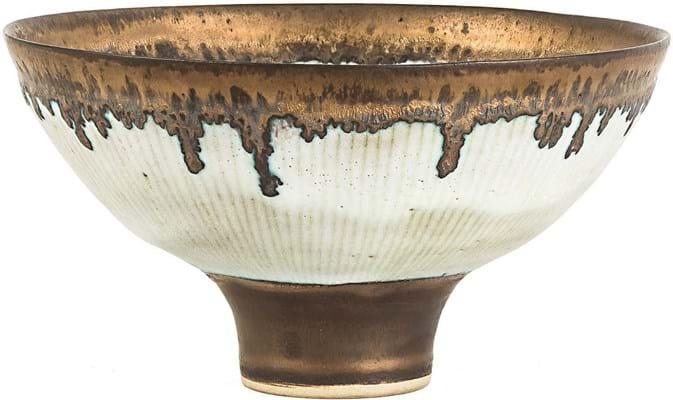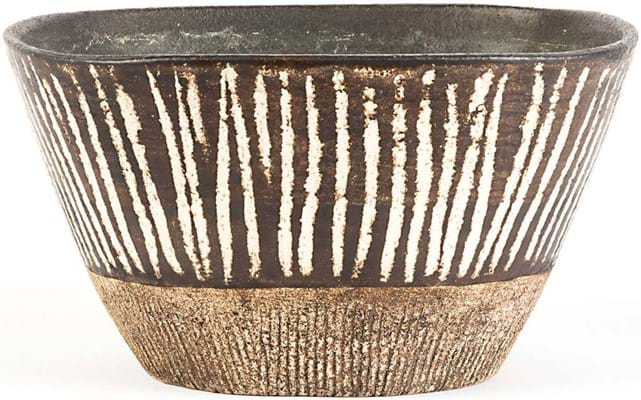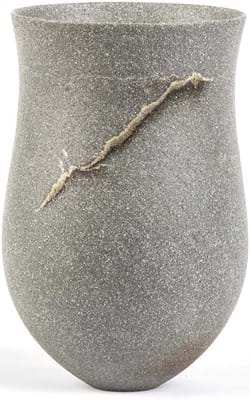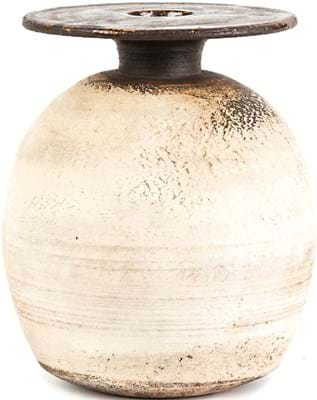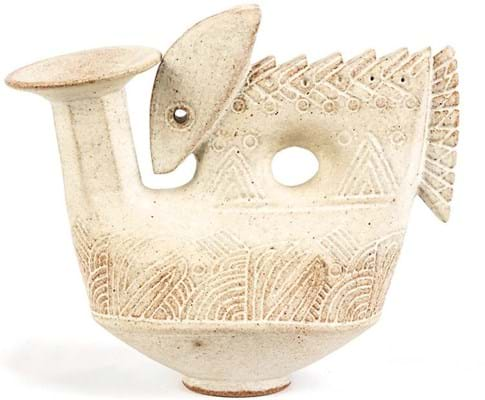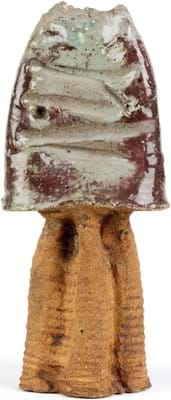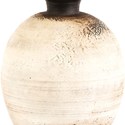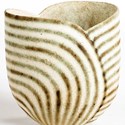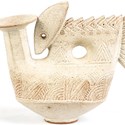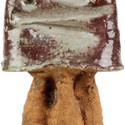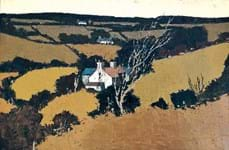McGuire Cravens, who died earlier this year, was a much-travelled philanthropist, whose donations included 110 works to the University of Buffalo.
Her studio ceramics were part of an ensemble of around 300 lots that also encompassed modern design and a selection of antiquities and ethnographica.
British, American and European artist-potters, both past and present, were offered.
Matt Cottone said she had done much of her purchasing from the late 1970s-90s during the first wave of popularity for studio ceramics.
Many pieces were purchased from the Galerie Besson in London, one of the trailblazing dealers in this field in the latter decades of the 20th century, or from the Graham Gallery in New York.
Hot tickets
It was the British pieces, especially those by the hot tickets Lucie Rie and Hans Coper, that were the most sought after. With a few notable exceptions – including a $160,000 (£118,520) Cycladic head and a $130,000 (£96,295) Alexander Calder sculpture – they achieved the highest prices in the collection.
Cottone reckoned that the majority of the pots lots sold to private purchasers, a mix of Americans and collectors from Europe.
However, he noted some buying by galleries, a reflection of how much crossover there now is between a once niche collecting field and the modern art and design arena.
Time was, back in the previous century, when Hans Coper (1920-81) would have topped any sale of British studio ceramics but more recently fellow potter and Coper’s one-time teacher Lucie Rie (1902-95) has overtaken him in the popularity stakes.
A classic Rie piece realised the highest price here. The 7½in (19cm) diameter footed bowl was decorated with a manganese glaze to the rim and foot and inlaid to the body with fine green lines. Like most of the pieces in the property, it carried an estimate that, at $8000-12,000, was conservative in view of what Rie is making these days.
It was therefore no surprise to see it outstrip that level to take $48,000 (£35,555), paid by a British collector bidding in the room.
The most expensive Coper was another familiar design, a 6½in (11cm) pot with a flattened disc top signed HC and dated to c.1965. A purchase from the Graham Gallery, it realised $34,000 (£25,185) against a $10,000-15,000 guide, selling to an American collector.
A Rie and Coper collaboration – a 9½in (24cm) wide broad-rimmed stoneware bowl of c.1952, with sgraffito decoration to reveal a white slip underglaze – was another top lot. Impressed with both the LC and HC seals, this had come from a 1987 Christie’s auction and had been shown at the Potters in Parallel exhibition at the Barbican Gallery in 1997. It sold for $20,000 (£14,815).
Mason spearhead
Between these two in price was a large 20in (50cm) high stoneware Spear Sculpture of 1963 by the American potter John Mason (b.1927) that had been acquired from the Garth Clark Gallery. Cottone’s guide of $4000-6000 was blown out of the water in favour of the final $43,000 (£31,850) price.
Mason’s series of ‘Vertical Sculptures’ from the early 1960s are among his most distinctive wares, associated with contemporary trends in Abstract Expressionism.
Among the next generation of British potters whose stars have been rising recently are John Ward (b.1938) and Jennifer Lee (b.1956).
The specialist London studio pottery auctioneer Maak Contemporary Ceramics has achieved a string of five-figure prices for Ward’s work at auction recently, especially for his striking black-and-white contrast vessels, with more coming up for sale in November.
Meanwhile, Mallams in Oxford has racked up several strong prices for Lee’s hand-built pottery, setting a £13,000 auction record for the Scottish-born potter in 2016.
It was therefore to be expected that work by these two artists might well outstrip Cottone’s estimates at this sale.
The four Lee pots in the McGuire Cravens property were led at $11,000 (£8150) by Balanced Trace, a 7½in (19cm) high slate blue stoneware vessel. Of the four John Ward vases, a lot containing two small black-and-white vessels from c.1986, measuring 6½in (17cm) and 4¾in (12cm), realised $6800 (£5040) while the highest individual price was for a 5in (13cm) high green-banded vessel at $4800 (£3555).
John Ward factfile
- John Ward was born in Islington, London, in 1938 and became interested in pottery after attending evening classes. He went on to study ceramics at Camberwell School of Art in the late-1960s under Lucie Rie and Hans Coper.
- He had two workshops in London in the 1970s, before moving to Dyfed, Wales, in 1979. His hand-built coiled stoneware pots use matt glazes and are influenced by both his early mentors as well as ancient pre-glaze pottery from China and Egypt.
- His graphically strong black-and-white vessels have proven particularly popular in recent years: the 16in (40cm) Tall Vessel c.1995, pictured below, realised £18,000 in May 2016 at Maak Contemporary Ceramics.
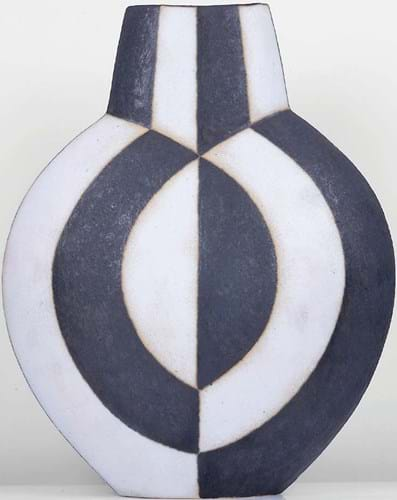
John Ward 16in (40cm) Tall Vessel c.1995, which realised £18,000 in May 2016 at Maak Contemporary Ceramics.
Jennifer Lee factfile
- Born in Aberdeenshire, Scotland, in 1956, Jennifer Lee studied ceramics and tapestry at Edinburgh College of Art, before travelling to the US to study South-West Indian prehistoric ceramics.
- Her pots are hand-built, do not use a wheel or glazes, and are admired for their earthy simplicity and organic, asymmetrical forms. Her 1997 Pale Pot, Speckled Emerging Rim, below, reached £13,000 at Mallams in December 2016, an auction record. The vase formed part of the exhibition Twenty-five Years, Craft Council Shop at the V&A in 1999.
- Lee, who works from a London studio, has items in major collections, including the Metropolitan Museum of Art in New York and the Victoria and Albert Museum.
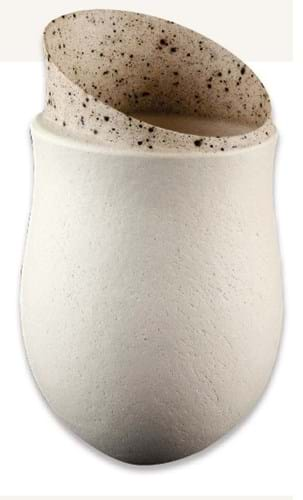
Jennifer Lee’s 1997 Pale Pot, Speckled Emerging Rim reached £13,000 at Mallams in December 2016, an auction record.
Steady performance
Not everything flew past Cottone’s reasonably pitched guides.
A 15in (38cm) high late tenmoku glazed bottle vase from c.1968 by the grand old master of the British studio movement, Bernard Leach (1887-1979), came in just over estimate at $3000 (£2220) while one of Peter Hayes’ (b.1946) trademark forms, a square-shaped, bowed, black etched pot of c.1993, took a within-estimate $1000 (£740).
Other American and European pieces gave similar performances and significantly, virtually every piece of studio pottery in the collection found a buyer.
Ancient sculpture
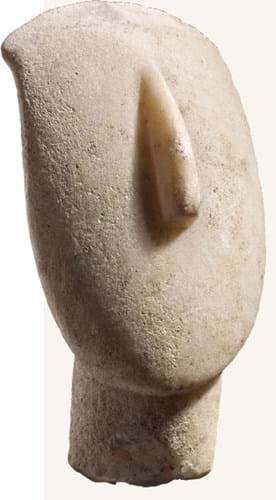
Leading the Annette McGuire Cravens collection sale at Cottone was this marble Cycladic head from the 3rd millennium BC which sold for $160,000 (£118,520).
Leading the Annette McGuire Cravens collection sale was this marble Cycladic head, above, from the 3rd millennium BC. The head, from a figurine, is a typical example of this much-admired ancient sculpture from the Aegean area of the Mediterranean.
It stands 5½in (13cm) high and is of so-called late Spedos variety. It has a provenance back to the late 1960s/early 70s when it was acquired by Dr Charles Alexander Best of Toronto, a member of the Canadian parliament and son of Dr Charles Herbert Best, one of the co-discoverers of insulin.
Annette McGuire Cravens acquired the head in 1979 from the Little Museum, Toronto as part of Dr Best’s estate and the lot came with the gallery’s original sale documents.
Cottone estimated the piece at $60,000-80,000 but it attracted national and international interest and 10 would-be phone bidders. This contest drove it to $160,000 (£118,520) at which point it was hammered down to a New York purchaser.
£1=$1.35


